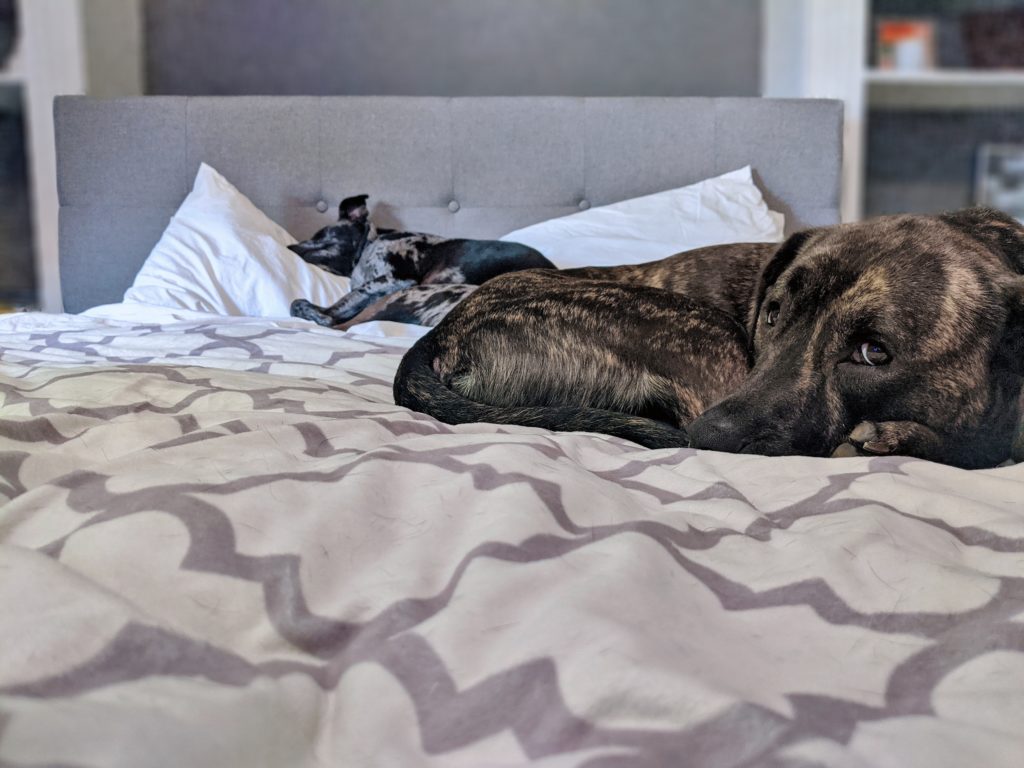Today’s blog is guest-written by Susanna Harris, who recently defended her PhD thesis at the University of North Carolina in Chapel Hill.
I just defended my PhD. Nearly six years of blood, sweat, and tears, most of which were cleaned up with Kimwipes while sitting at my desk in a laboratory facing out towards the UNC Chapel Hill football field. Nearly six years of work, all summed up in a handful of slides. Nearly six years of work, explained to my friends, family, and colleagues – a moment I had dreamed of since the fall of 2014.
What I hadn’t dreamed of? That I would be sitting at my small desk in the corner of my room, with no present audience aside from my snoring dogs. That there would be no dinner celebration that carried into a night of fun along Franklin Street. That, unseen by the viewers of my defense, I would be wearing sweatpants as my name changed from Ms. to Dr. Harris.

Why did I wear sweatpants when I could have worn literally anything in my closet? Because I think it’s hilarious. I believe this situation will end and we will walk away with memories and lessons learned from an extremely difficult time in the history of the world. I want to walk away with one more ridiculous story to add to a long list of “What even was that?” tales from grad school.
Working towards a PhD is hard at any time; let’s not pretend this pandemic isn’t making things even worse. I was fortunate in many ways that my advisor had already moved our laboratory to a new state in 2019, allowing me to adjust to meeting through webcams and working from home before the pandemic changed the lives of all North Carolinians. This has given me a unique perspective to tease out which problems come from distance working and which are the result of Safer-At-Home orders. Based on my experiences, here are a few tips, tricks, and words of warning.
You probably can’t actually work for eight hours a day – at least not for many days in a row.
We often forget how much time is spent commuting, talking with colleagues, getting settled in, skimming through the internet or walking around for breaks, and even eating lunch or getting coffee. Take a moment to chart out your “normal” workday from last semester (nobody will read this, so be as honest as you can) and then back-calculate how many hours of work that is. Did you have a super variable schedule? That’s okay! Chart out a few days, including your longest and shortest, and find an average. Then, don’t expect yourself to work any more than this when you are making your daily schedule.
Schedules are meant to be broken.
Don’t be afraid to set a schedule just because you can’t stick to it. Even when we were in grade school, with clear systems for scheduling and crowd control, events and daily circumstances still shifted our routines from time to time. Based on your calculations above, create a schedule that you think is reasonable. One way to do this is to work with a friend to come up with each of your schedules (they will likely not be exactly the same). Put in a few rules and guidelines; I don’t check social media before 10AM or after 9PM, I eat meals at regular-ish times, I take one or two longer breaks throughout the day. And then see how it goes! This is an experiment for yourself, and you will have plenty of opportunities to learn and adjust along the way. Bonus: whatever you learn about yourself now will probably help you navigate future situations you won’t expect, like when you are supervising others or have to work under different stressful situations.
Keep track of your efforts.
While writing my dissertation, I felt like I was running in place most days. After three hours of work, I might have two paragraphs or a draft that was formatted in a slightly different way. That didn’t feel great, and I quickly realized that measuring progress using checkboxes to indicate a project was “done” really wasn’t helpful in the long term. I switched to measuring the amount of time I spent working on a project without distractions. Whether writing emails, editing a paper, or nudging figures three pixels to the left, I counted in minutes and hours. I found the time-tracking app Toggl to be helpful in watching where my time was actually going and reminding me that I actually *had* made progress over the week. Again, figure out what is reasonable as you go – I ended up only writing for three hours a day, but for two days in a row with one day off in between.
Take breaks.
Here’s some fun human psychology: we can’t work constantly for long periods of time day-in and day-out. Eventually, our brains need to recharge, and pushing ourselves into the ground will make it harder to come back the next day. One of the best pieces of advice I ever got was to “start before you want to, and end before you want to.” I used the Forest app to choose a duration of time to work without distractions followed by a mandatory break where I couldn’t continue working – this is called the Pomodoro method, and usually consists of 25-minutes working with 5-minute breaks. Once you get going, it can be hard to stop, but beware! If you don’t reward yourself after your work with some time off, your brain will remember this the next time you’re trying to settle in to focus. Once your brain adapts to the idea that this isn’t a long sentence, you’ll find it easier to get started on projects. Instead of continuing, write down the next task you want to jump into when you restart.
Everyone is both internally and externally motivated.
One of the most ludicrous things I ever heard in grad school came from a supervisor of sorts. After I told them that I was mostly externally motivated, they said “If you are going to get through grad school, you need to figure out how to be completely internally motivated.” At best, this was a projection of their own beliefs and feelings. At worst, it was an excuse for poor management and lack of empathy. Either way, I tried for months to just get-it-together and become a new person. Guess what! That didn’t work. Instead, I had to take charge of finding motivation in my own ways. By connecting with other advisors and colleagues, I created accountability meetings; these self-imposed deadlines became a source of much needed external motivation.
Treat yourself like you would a friend.
Here’s where the “working from home before COVID-19” advice comes in. Even though I’d settled into a pretty good routine over a few months, the pandemic threw me way off. I am still terrified of the future. My life has still flipped upside down. And there is no way that I am nearly as productive as I was in January, when I could still work at a coffee shop or meet friends in person. No matter how productive you might have been before the pandemic, you likely won’t be right now. That’s okay. You are surviving through a global tragedy and facing fears that would throw anyone way off track. Show yourself the same compassion as you would to a friend during this time. Give yourself a break.
We are living in a time of chaos; we don’t know what the next month, let alone the next year, will bring. If you are out there struggling to keep going through all of this: you aren’t alone. Do whatever you need to just get through this time: maybe that’s calling a friend every day; maybe that’s creating space in your schedule to practice yoga or meditation; maybe that’s learning a new skill or taking up a hobby that you’ve always wanted to try. Or maybe that’s wearing sweatpants during one of the most important days of your life.

Susanna L. Harris, PhD, completed her PhD at the University of North Carolina in Chapel Hill. Susanna studies how different types of bacteria stick to the roots of plants. She hopes this research could help improve agricultural use of beneficial bacteria in place of harsh chemical fertilizers.
Susanna started PhD Balance to empower students to build personal and professional resilience during Graduate School.
Susanna can be found on Instagram and Twitter at @susannalharris
PhD Balance can be found at @PhD_Balance and at www.PhDBalance.com
Looking for more resources for graduate school? Check out our Student Resource Center, where you can find tips for job searching and resume building, alongside helpful resources for common techniques you might use in the lab.
Related Posts
Latest posts by Promega (see all)
- AI in the Research Lab: Where We Are, and Where We’re Going - April 9, 2024
- Blending Art and Science in a Costa Rica Physics Lab - February 8, 2024
- Elevate Your Research: Exploring the Power of 8-Dye STR Chemistry with the Spectrum Compact CE System - October 25, 2023

One thoughtful comment